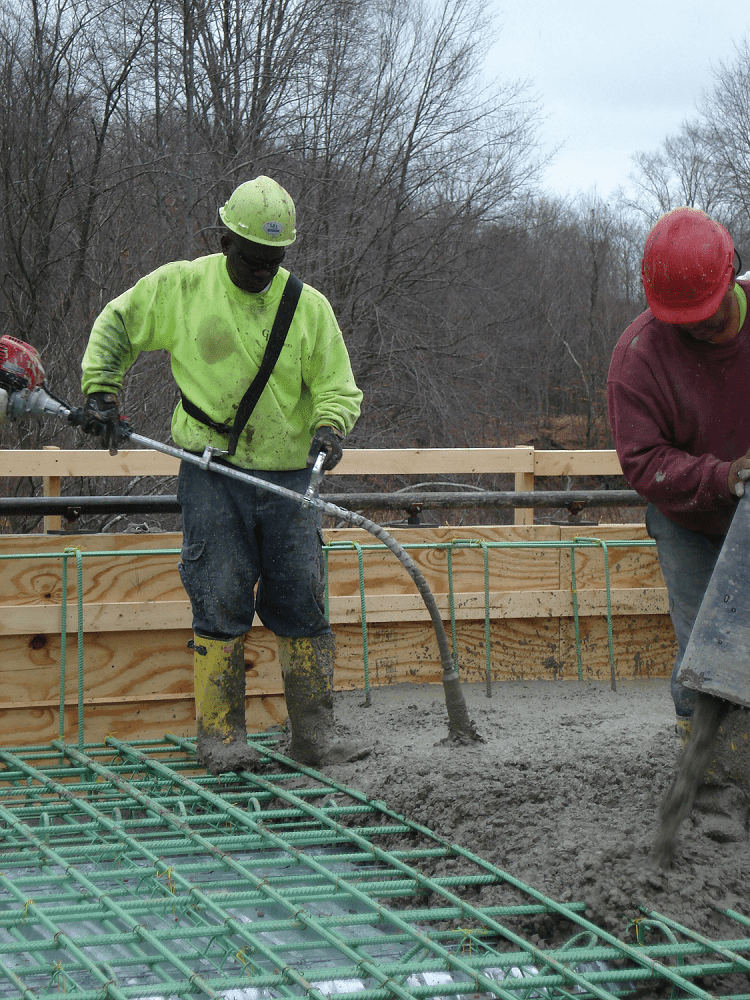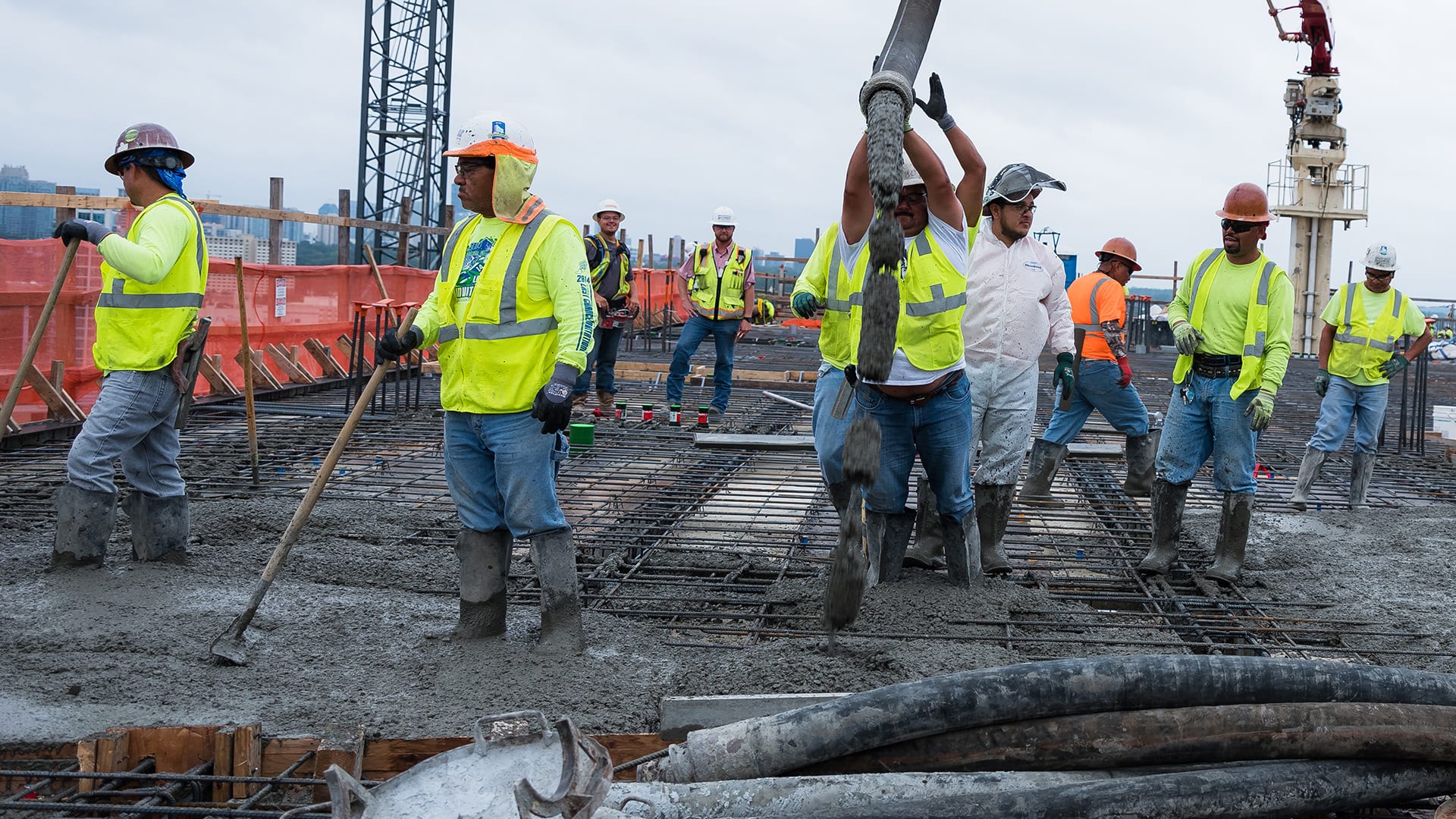5 Questions You Must Ask Your West Coast GE Concrete contractors Before Breaking Ground
5 Questions You Must Ask Your West Coast GE Concrete contractors Before Breaking Ground
Blog Article
The Necessary Duty of Concrete Structure in Structural Stability and Durability
When it comes to constructing a building, the structure is extra critical than you could assume. Concrete structures give unmatched toughness and longevity, ensuring your framework can hold up against numerous ecological difficulties. Without a solid base, you risk potential issues like changing or cracking, which can endanger security and worth. Comprehending the nuances of concrete structures can be the key to maintaining your financial investment for many years to come. So, what should you consider following?
Comprehending the Significance of Concrete Foundations
Concrete foundations are crucial to the general security of any type of structure, as they provide the crucial assistance needed to hold up against different loads and ecological problems. When you believe about developing a home or a commercial area, the foundation is the initial thing you should take into consideration. It acts as an obstacle against wetness, securing your home from water damages. A well-placed concrete structure also stops settling and shifting, which can cause cracks in wall surfaces and floors. You'll want to ensure that the structure is correctly created and strengthened, as this affects the durability of your structure. Additionally, a solid structure can boost energy effectiveness by reducing air leaks. Bear in mind, neglecting the value of a concrete structure can result in expensive fixings down the line. Spending in a quality foundation upfront is necessary for the integrity and sturdiness of your structure.
Benefits of Concrete Foundations for Structural Stability
While lots of aspects add to a structure's architectural honesty, concrete foundations use unequaled sturdiness and stamina. You'll value that concrete can hold up against severe weather, withstanding both moisture and temperature fluctuations. This resilience implies your structure is less likely to experience breaking or shifting over time, which can compromise its safety.Additionally, concrete's inherent weight provides a solid base, avoiding movement during all-natural events like earthquakes or floodings. When you select a concrete foundation, you're also selecting low upkeep; unlike timber, it won't rot or attract pests, conserving you time and cash in repairs.Moreover, concrete's fire resistance supplies included security, ensuring your structure can sustain heats without substantial damage. In general, investing in a concrete foundation suggests you're focusing on the long-lasting stability and integrity of your building, making it a smart option for any type of construction job.
Common Kinds of Concrete Foundations
When it concerns developing foundations, understanding the typical kinds of concrete foundations can aid you make educated selections for your project. One of the most widespread kinds consist of slab-on-grade, crawl space, and full basement foundations.A slab-on-grade structure is a straightforward, economical option, where a thick concrete piece is poured straight on the ground. This type functions well in cozy climates, as it reduces heat loss.Crawl area structures elevate the home a little above ground, permitting ventilation and access to pipes and electrical systems. This layout can help stop moisture issues.Full basement foundations use additional living or storage area while providing superb structural support. They require more excavation and are generally made use of in colder environments to stop frost heave.
Variables to Consider When Designing a Concrete Structure

Ideal Practices for Installing Concrete Foundations
When you're setting up a concrete structure, proper website prep work is necessary to guarantee stability (West Coast General Engineering industrial concrete). You'll likewise require to recognize support methods to improve strength and resilience. Don't ignore the healing process, as it plays an essential duty in achieving a strong structure.
Site Preparation Significance
Although it might appear simple, proper website prep work is crucial for guaranteeing a solid and resilient concrete structure. Start by removing the area of any kind of particles, vegetation, or natural product that might compromise the structure's stability. Next, assess the dirt kind and compaction; you may need to dig deep into or include materials to create a secure base. Level the ground to assure even weight circulation and prevent working out concerns in the future. Setting up correct drainage systems is additionally important to avoid water buildup, which can damage the foundation over time. Mark out the foundation's dimensions properly to direct the pouring process. By complying with these actions, you'll establish the stage for a successful concrete foundation that stands the examination of time.
Support Strategies Discussed
When the website is effectively prepared, the next action in assuring a sturdy concrete foundation entails applying efficient support techniques. You need to start by making use of steel rebar, which offers tensile toughness and helps avoid splitting. Lay the rebar in a grid pattern, making certain it rises using spacers to preserve correct protection. In addition, consider utilizing cord mesh for extra support, especially in locations subject to heavy loads. Don't fail to remember to connect the rebar junctions firmly with wire. For larger foundations, fiber support can boost resilience, minimizing the threat of shrinkage splits. Constantly adhere to regional building regulations and guidelines to guarantee compliance. By applying these reinforcement methods, you'll significantly increase your foundation's stamina and durability, laying a solid foundation for your structure.
Treating Process Basics
To guarantee your concrete foundation remedies appropriately, it is necessary to maintain adequate moisture and temperature level problems instantly after putting. Begin by covering the surface with a damp cloth precast steps or plastic bed linen to retain moisture. This keeps the concrete moisturized, protecting against fractures and ensuring strength. You should also monitor the temperature; perfect curing conditions are between 50 ° F and 90 ° F. If it's also hot, mist the surface routinely to avoid rapid evaporation. For winter, take into consideration utilizing insulating blankets to keep warmth. Purpose for a treating period of a minimum of seven days, as this is essential for optimal toughness development. By complying with these ideal methods, you'll improve your structure's sturdiness and longevity, guaranteeing architectural stability for years to find.
Upkeep of Concrete Foundations for Durability
To maintain your concrete structure strong and long lasting, normal inspections are vital. You need to also ensure efficient water drainage solutions are in area to prevent water damage. If you identify any kind of splits, addressing them quickly will conserve you from larger troubles down the line.

Routine Assessments and Assessments
While regular examinations and assessments might appear like a task, they're essential for keeping the integrity of your concrete structure. By regularly looking for cracks, shifts, or indicators of wear, you can catch possible problems prior to they intensify right into expensive fixings. Try to find any water pooling around the foundation or uncommon settling, as these can indicate underlying problems. It's additionally a good idea to check any type of adjustments in your home's framework, like doors that stick or home windows that don't open smoothly. Maintaining a record of your assessments aids track modifications with time, enabling positive upkeep. Ultimately, these analyses ensure your foundation continues to be steady, supporting the durability and safety and security of your entire framework. Do not overlook this important facet of homeownership!
Effective Drain Solutions
Normal inspections can expose concerns like drainage problems that may endanger your concrete structure's stability. To stop water buildup, guarantee your rain gutters and downspouts straight water far from the foundation. Installing French drains can effectively reroute surface and groundwater, decreasing stress on your structure wall surfaces. Furthermore, rating the soil around your home assists assure that water streams away, as opposed to merging near your foundation.Consider making use of sump pumps in areas vulnerable to flooding, as they proactively eliminate excess water. Regularly inspect for blockages in drainage systems and clear them without delay. You'll safeguard your foundation's honesty and long life by taking these positive measures. Remember, efficient drain remedies are vital for keeping a solid, sturdy concrete structure.
Motivate Fracture Repairs
When you discover fractures in your concrete structure, addressing them promptly is crucial for preserving its longevity. Tiny splits can swiftly advance into larger concerns, jeopardizing the architectural integrity of your home. On a regular basis examine your foundation for indications of damage, such as horizontal or upright splits. If you identify any type of, don't wait-- repair them right away. You can utilize epoxy injections or concrete patching substances, which are reliable for securing fractures. Always adhere to the maker's guidelines and consider getting in touch with a specialist for considerable damages. Bear in mind, prompt fixings not only boost your structure's resilience however likewise save you money in the long run by stopping a lot more substantial repair services down the line. Stay proactive, and your foundation will find out this here certainly stay solid and protected.
Resolving Common Concerns With Concrete Foundations
Concrete foundations can encounter various concerns over time, making it vital to identify and resolve them quickly. Among the most common troubles is breaking, which can take place because of temperature changes or working out dirt. If you observe cracks, it's necessary to evaluate their dimension and deepness; tiny fractures can usually be secured, while larger ones might require specialist evaluation.Water invasion is one more major worry. Excess moisture can cause mold growth and structural damage. Assurance proper drain around your structure to mitigate this risk. Furthermore, look for indications of changing or bowing walls, as this can indicate underlying concerns with your foundation's stability.Regular inspections are fundamental to catch these issues early. If you detect any worrying indicators, don't wait to seek advice from a foundation specialist. By remaining positive, you can preserve the stability and durability of your concrete foundation, guaranteeing your home stays secure and secure.
Frequently Asked Inquiries
Just How Does Soil Kind Impact Concrete Structure Efficiency?
Dirt kind greatly influences concrete foundation efficiency. If you've obtained expansive clay, for example, it can cause moving and fracturing. Sandy dirt could lead to settling. Recognizing your soil assists assure a stable structure.
Can Concrete Foundations Be Fixed if Damaged?
Yes, you can fix broken concrete foundations. Depending on the level of the damage, techniques like epoxy injection or piece jacking can recover security. It's best to consult an expert for reliable options.
What Is the Regular Lifespan of a Concrete Structure?
A concrete foundation usually lasts 30 to 100 years, relying on variables like soil conditions, climate, and upkeep. You'll wish to keep an eye on it to assure it continues to be healthy throughout its life-span.
Exist Alternative Materials to Concrete for Foundations?
Yes, there are options to concrete for foundations, like steel, timber, or perhaps recycled products. Each alternative has unique basics benefits and disadvantages, so you must consider your task's details demands when choosing the best material.
Exactly How Does Climate Influence Concrete Structure Sturdiness?
Environment considerably influences concrete structure longevity (West Coast General Engineering concrete foundation Rancho Cucamonga). Extreme temperature levels, dampness, and freeze-thaw cycles can damage the material, leading to splits and structural problems. You need to take into consideration regional climate conditions when planning your structure to ensure long-lasting performance
Report this page